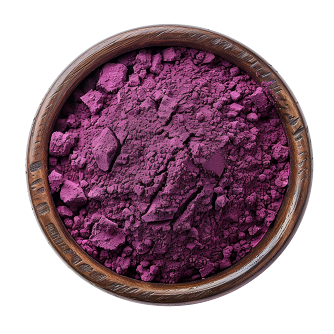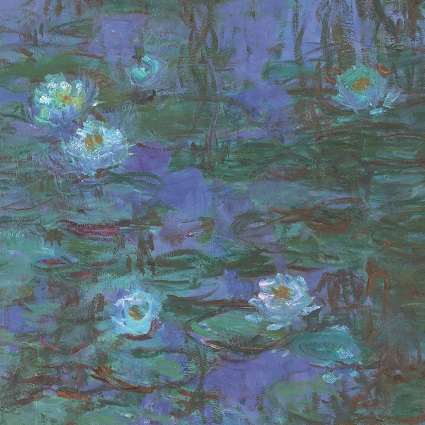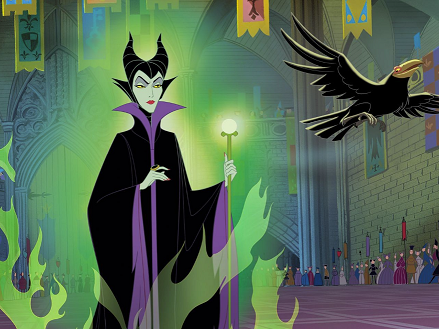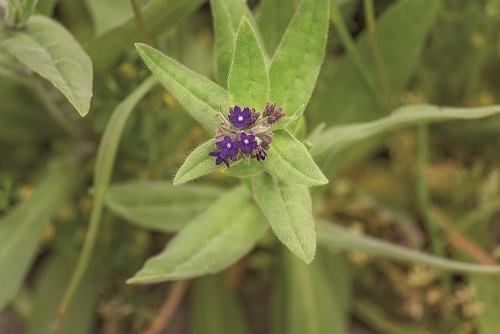Considered one of the rarest colours in nature, purple has always been synonymous with uniqueness. Its duality – it is created by combining blue, a symbol of calm, with red, an emblem of passion – gives it a unique, evocative power. It represents good fortune and prosperity in the East but also power and black magic in the Western tradition, remaining steeped in history and mystery and capable of inspiring and fascinating even today.
Purple is a colour that has spanned the centuries, evoking complex emotions and conveying deep meanings. From delicate shades of lilac to intense tones of violet, it has been playing a role in many fields, from art to fashion, becoming a symbol of spirituality, mystery, and nobility. Rarely chosen by children in their drawings, it hides a history full of complexity and ambiguity that we often only fully understand in adulthood.
A symbol of luxury and royalty in many cultures, it has also taken on darker connotations, being also associated with bad luck, death, and mourning. Its rarity in nature makes it an exclusive colour, imbued with an aura of preciousness.
Created from the combination of blue’s soothing calm and red’s vibrant strength, purple can evoke different feelings depending on its shades, from spirituality and meditation to a sense of magic and transformation.
Besides its symbolic significance, it has also played an essential role in the history of pigments. In ancient times, obtaining a dye in this colour required complex and costly processes, such as extracting it from marine organisms, which helped cement its association with the upper classes. Even today, its chromatic complexity makes it a fascinating hue, capable of stimulating imagination and establishing itself as a distinctive choice in any context.
The origin of the word “purple”
This colour’s name derived from Latin purpura (indicating the same hue), which in turn came from Greek porphura (denoting the molluscs that yielded a dye in this tint and the fabric dyed with it). The name of one of its shades, violet, similarly to purple’s name in other languages (viola
in Italian and violet in French – morado in Spanish has a different history linked to moras, “blackberries”), derived from Latin viola, from the flower that grows wild in temperate climates. Its etymology, which goes back to the Indo-European root wi- (meaning “to bend” or “to turn”), recalls the transition between red and blue, symbolising this hue’s elusive and mysterious nature.
Purple in history: from an exclusive symbol to a popular colour
The history of purple is as fascinating as it is rich in meaning and transformation. Associated with royalty, spirituality, and mystery, this colour has spanned the millennia, linking itself to cultures, religions, and artistic movements. It has its roots in ancient times, when Tyrian purple, a dye obtained from thousands of molluscs, was the ultimate symbol of luxury, power, and royalty. About 12,000 molluscs were needed to obtain just 1.5 grams of dye, making purple exclusive to the elite.
 About 12,000 molluscs were needed to produce 1.5 grams of Tyrian purple. © AdobeStock
About 12,000 molluscs were needed to produce 1.5 grams of Tyrian purple. © AdobeStockRoman emperors such as Elagabalus made it an emblem of their power, whereas the founder of the Persian Empire, Cyrus the Great, adopted it as his personal symbol in the 6th century BC.
In Christianity, purple acquired profound connotations. Around 1200, Pope Innocent III designated it as a symbol of penance, and it became the official colour of the clergy during the liturgical seasons of Advent and Lent. Catholic and Anglican bishops still have purple in their vestments today. In modern times, this hue has continued to play a similarly important role by being worn by scholars and university professors to communicate authority and wisdom.
For centuries, its production remained complex and expensive until a breakthrough in 1856: a young British chemist named William Henry Perkin, while attempting to synthesise quinine, accidentally discovered a deep purple dye that he called mauveine. This event marked the creation of the first synthetic dye and revolutionised the world of chemistry. Perkin industrialised the process, making purple accessible to all – and turning it from an exclusive symbol of luxury to a mass colour.
The role of purple in art and corporate communication
Purple has always fascinated artists because of its ability to evoke complex emotions. In visual arts, dark purple is often associated with elegance and luxury, whereas lilac and lavender are linked to tranquillity and calm.
In the 19th
century, the introduction of cobalt violet enriched the painters’ palettes, opening up new expressive possibilities: initially toxic, this pigment was later improved, becoming a key element for artists such as Paul Signac, the master of Pointillism, who used purple shades to create colour harmonies in his landscapes.
Claude Monet, the father of Impressionism, used violet to lend depth and mystery to his iconic water lilies; the series “Les Nymphéas”, shown in major exhibitions in Paris and New York, is testimony to this. Purple is also found in Vincent van Gogh’s masterpieces, including his famous depictions of irises and starry skies, where he combined it with complementary yellow to create exciting and vibrant contrasts.
 Nymphéas bleus, 1916-1919. Claude Monet. © Musée d’Orsay, Dist. RMN-Grand Palais / Patrice Schmidt
Nymphéas bleus, 1916-1919. Claude Monet. © Musée d’Orsay, Dist. RMN-Grand Palais / Patrice SchmidtKnown for its ability to attract attention and convey deep emotions, this colour has been used not only in art but also in design to communicate sophistication and originality. Therefore, it is not surprising that many successful brands have chosen purple as a distinctive element of their visual identities, harnessing its evocative power to create a strong connection with the public.
In corporate communication, this hue is the protagonist of numerous brand images. Service provider Yahoo! uses it to convey strength and mystery. Swiss chocolate producer Milka has been using it to represent sweetness and quality since 1901. Transport company FedEx’s logo combines purple with orange to emphasise the concepts of innovation and professionalism, whereas its iconic white arrow is a masterpiece of graphic design. Taco Bell distinguishes itself in the fast food sector with purple, evoking comfort and originality. LA Lakers pair it with yellow as a symbol of courage. Finally, airline Wizz Air relies on this colour to communicate affordable luxury even on low-cost flights.
 Service provider Yahoo! uses this colour to convey strength and mystery; Swiss chocolate producer Milka has been using the colour violet since 1901 to symbolise sweetness and quality; Transport company FedEx’s logo combines purple with orange to emphasise the concepts of innovation and professionalism, whereas its iconic white arrow is a true masterpiece of graphic design. © AdobeStock
Service provider Yahoo! uses this colour to convey strength and mystery; Swiss chocolate producer Milka has been using the colour violet since 1901 to symbolise sweetness and quality; Transport company FedEx’s logo combines purple with orange to emphasise the concepts of innovation and professionalism, whereas its iconic white arrow is a true masterpiece of graphic design. © AdobeStockPurple in fashion
With its duality, poised between sophistication and eccentricity, purple has always been a distinctive choice in the fashion world. Ever since the Victorian era, when synthetic dyes such as mauveine allowed it to become more widely available, it has established itself as a symbol of luxury and social status. Internationally renowned fashion designers such as Valentino, Versace, and Alexander McQueen have used purple in iconic collections to evoke elegance and an aura of mystery.
While deep shades such as violet and aubergine express royalty and opulence, lighter shades such as lavender or lilac communicate romanticism and delicacy. At the same time, purple has also been associated with an aesthetic of rebellion and nonconformity: in the 1970s, it was a central element of the glam rock style, adopted by artists such as David Bowie and bands such as Queen. In recent years, it has become an emblematic colour for fashion shows aiming to break with conventions and surprise, bringing a feeling of avant-garde and innovation. Purple, therefore, is a versatile choice for designers, capable of communicating sophisticated luxury or creative rebellion depending on the context while always maintaining a strong visual impact. It continues to star on catwalks and red carpets, representing a style that combines tradition and modernity.
Purple in pop culture
Besides visual arts, purple has profoundly influenced popular culture, taking on different meanings depending on the context. In music, it has become an emblem of sensuality, rebellion, and experimentation thanks to icons such as Prince, whose “Purple Rain” is not only a style manifesto but also a symbol of introspection and passion, and Jimi Hendrix, who turned this colour into a psychedelic and visionary symbol of the 1960s counterculture with his “Purple Haze”.
In film and literature, purple is associated with mystery, magic, and emotional introspection. In the dreamlike landscapes of “Alice in Wonderland”, it embodies the surreal and the fantastic; in futuristic settings of science fiction films such as “Blade Runner” or “Dune”, it represents advanced technology, alienation, and enigmatic beauty. Purple also frequently appears in fantasy films, such as the “Harry Potter” saga, often linked to magic potions, spells, and settings related to the unknown.
It has also found its way into animation: think of iconic characters such as Maleficent from “Sleeping Beauty”, whose use of purple conveys an idea of power, darkness, and mystery, or the Cheshire Cat, whose enigmatic smile and purple shades accentuate its unpredictable and magical nature.
 In the case of Maleficent, the antagonist of Sleeping Beauty, purple represents power, darkness, and mystery. © Disney
In the case of Maleficent, the antagonist of Sleeping Beauty, purple represents power, darkness, and mystery. © DisneyFinally, in video games, purple is often used to represent magical powers, cosmic energy, or particularly charismatic characters, such as Mewtwo in “Pokémon” or Thanos in the Marvel Universe, who combines superhuman strength with psychological complexity. In other words, this colour confirms itself as a many-sided element, capable of representing sensuality, rebellion, mystery, and imagination in all forms of pop culture.
Purple in Western and Eastern cultures
In European and Western cultures, purple has had mixed meanings, both positive and negative.For centuries, as mentioned, it was associated with royalty and nobility, a symbol of wealth and prestige, especially during the Middle Ages, when purple pigments were expensive and difficult to obtain. However, purple also had darker connotations. In some traditions, its use on particular occasions, such as during times of mourning, was seen as bringing bad luck. Moreover, in popular culture, purple was sometimes associated with the devil and black magic, fuelling its connection with the unknown and the mysterious. In Christian symbolism, it was worn by priests during Lent and Advent, in the context of penance and spiritual meditation. In some Western cultures, moreover, purple is one of the colours avoided at weddings, along with white and black, because it is considered a symbol of sadness or infidelity. In fashion and television, it was sometimes perceived as a colour that brought bad luck, although today, it is used for elegance and originality.
In China, the perception of purple was peculiar. During the Han dynasty, it was not a commonly used colour and was considered relatively rare. However, in the ceramics and paintings of the time, it appeared as a symbol of an evolving art and a particular aesthetic sense. Its rarity and beauty made it fascinating, but it did not enjoy the same popularity as traditional colours such as red or yellow, which had stronger connotations of prosperity and good fortune. In brief, while appreciated, purple was not viewed with the same degree of veneration as other tints but rather perceived as a choice to detach from established traditions.
In Japan, purple acquired a meaning of great refinement and social status during the Heian period (794-1185). The pigment murasaki, extracted from the alkanet plant, was used to dye fabrics and paint and became a symbol of Japanese nobility. Its association with high social classes made it a favourite colour in the imperial courts, and even in the classics of Japanese literature, including “Genji Monogatari”, purple symbolised elegance and prestige.
 In Japan, the pigment murasaki was extracted from the flower of alkanet (Alkanna tinctoria) and used to dye fabrics and paint. © AdobeStock
In Japan, the pigment murasaki was extracted from the flower of alkanet (Alkanna tinctoria) and used to dye fabrics and paint. © AdobeStockIn Thailand, on the other hand, purple has a very different meaning. It is closely associated with mourning and used by widows and other people as a sign of respect for the dead. Here, this colour represents grief and remembrance, and it is chosen during times of mourning as a symbol of sadness and respect for death. In this context, it takes on a meaning of reflection and commemoration, far from its association with royalty or luxury typical of other cultures.